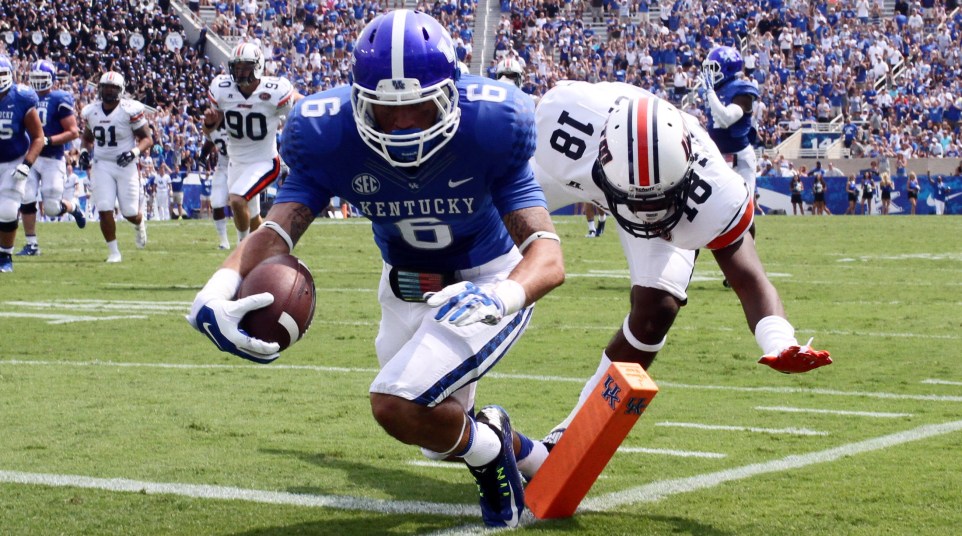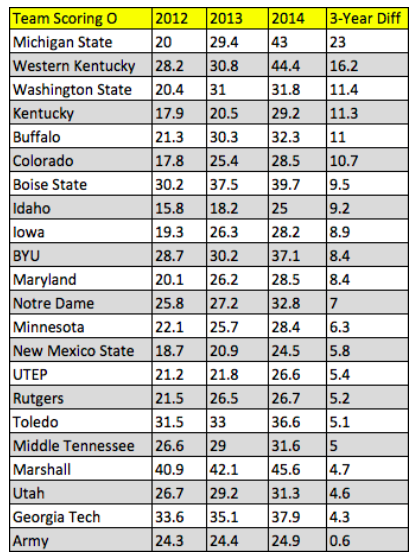Study shows move to Air Raid paying dividends for Kentucky
The Kentucky Wildcats are entering the third year running the second coming of Hal Mumme’s Air Raid offense, and although the Cats have won just seven games in the first year of the Mark Stoops/Air Raid era, the new system is working wonders in the Bluegrass.
According to a recent statistical analysis conducted by CoachingSearch.com, Kentucky’s offense is the fourth most improved unit in the entire FBS since the start of the 2012 season, the last season of the Joker Phillips era that predates Stoops and the return of the Air Raid to Lexington.
Only Michigan State, Western Kentucky and Washington State have experienced a greater rise in scoring offense from the start of the 2012 season to the end of the 2014 season, and no other SEC team ranks among the top 20 teams in the nation in additional scoring from 2012-14.
As you can see, only 21 teams of the 128 in the FBS experienced a rise in scoring of at least 4.3 points per game during the three-year window in question. It’s no coincidence that a UK team averaging fewer than 18 points a game during Phillips’ final season (a disastrous 2-10 train wreck of a season) was scoring nearly 30 points per game at the end of the second year of the Air Raid era.
What’s even more intriguing for the Wildcats is that UK has yet to return its starting quarterback for consecutive years commanding the Air Raid, something it can do this fall with the return of last year’s starter, Patrick Towles. The team also returns its top wideout in Ryan Timmons as well as five touted wideout signees from the 2o14 recruiting class.
The tools are there for Kentucky to continue this growth on offense. Kentucky ranked sixth in the SEC in passing offense a year ago despite completing only 56 percent of its passes, marking the ninth-best completion rate in the conference. Towles is now more experienced after a year as the starter. Four of the five 2014 signees mentioned above have a year of experience under their belts, and the Cats have continued to add pieces at tailback, tight end and along the offensive line, allowing the personnel to better fit the system.
Experience and more suitable personnel can make all the difference. They already have throughout the first two years of the Air Raid’s return, and the entire unit is poised to hit its stride in 2015.
Furthermore, UK can actually run the ball, which is something most spread offenses cannot do effectively. The Cats ranked fourth-worst in rushing offense a year ago, but they return three of their top four backs from a year ago (two of whom were true freshmen last year) and 80 percent of their carries in 2014. UK’s numbers were held back by two games in which the team failed to crack 100 yards on the ground, but it’s also worth noting the Cats ran for more than 200 yards as a team in four of their 12 games last season.
Is it the most potent rushing attack in the SEC? No, not hardly. But is it a better rushing attack than many other spread offenses employ? Yes. And is it poised to improve from a year ago much like UK’s passing game? Once again, the answer is a resounding yes.
Kentucky’s improved scoring in its first two years running the Air Raid indicates the system was the perfect adjustment to inspire buzz and excitement around the UK program. It also helped UK win more games a year ago than it had won the two previous years combined.
And it is only going to continue to grow. The chart above is merely a marking point of UK’s growth into one of the more potent offenses in the daunting SEC, not the final results of the Air Raid experiment.
UK’s young, returning pieces must continue to work to find their roles in the Air Raid this fall. The personnel is already better suited to run the offense, and UK is attracting more talent in recruiting than it has under any other coach in recent memory.
Things are looking up in the Bluegrass, especially the offense and more specifically its point totals on a weekly basis.


